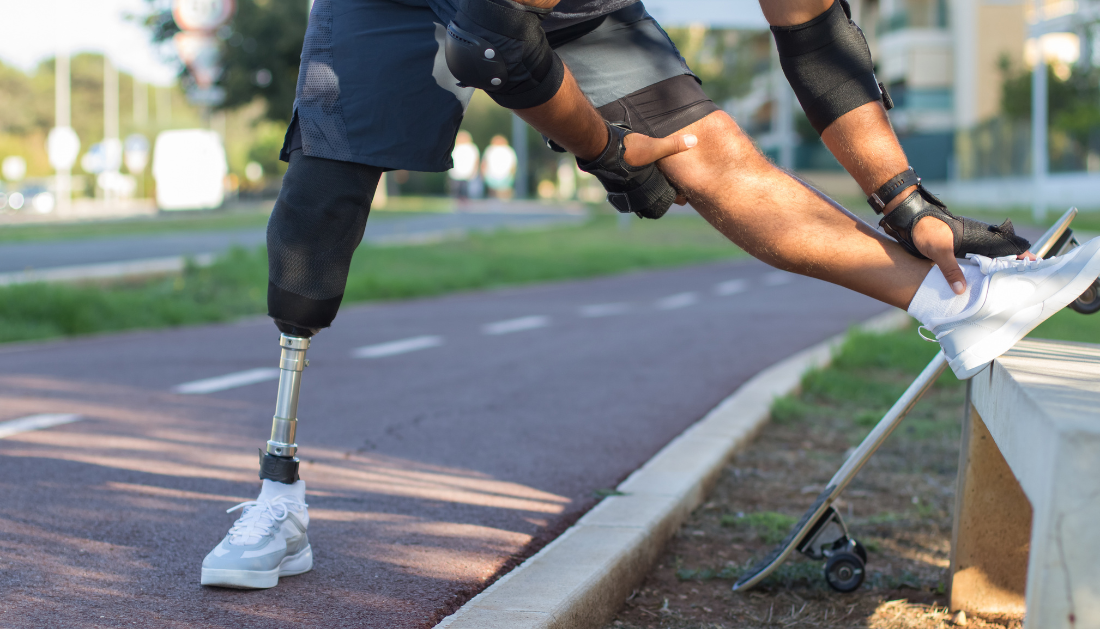

Spinal cord stimulation can elicit sensation in the missing foot and decrease phantom limb discomfort in persons with lower limb amputations, according to rehabilitation specialists at the University of Pittsburgh School of Medicine.
Pressure sensors on a prosthetic foot’s insole triggered electrical pulses, which were subsequently sent to a participant’s spinal cord. This sensory feedback improved balance and gait stability, according to the researchers. The proof-of-concept work was conducted in partnership with academics from Carnegie Mellon University and the University of Chicago, and it was published in Nature Biomedical Engineering.
“We’re using electrodes and stimulation devices that are already widely used in clinics and that physicians are familiar with implanting,” said senior author Lee Fisher, Ph.D., associate professor of physical medicine and rehabilitation at Pitt. “We are utilizing those technologies to produce meaningful improvements in function and pain reduction.” That’s exciting, and we’ve been working on it for quite some time.”
Eight out of ten Americans who have had a lower-limb amputation report persistent pain that is considered to be emanating from the missing leg or foot. This phantom limb discomfort frequently does not react to pain medications and significantly reduces quality of life. Furthermore, because even the most technically advanced prosthetics lack sensory feedback functionality, amputees continue to be vulnerable to balance deficits and falls, severely limiting their mobility.
Unlike a typical stimulation system, which works by overriding pain neurons with another sensory signal (similar to how rubbing your sore elbow helps relieve pain), Fisher’s team used existing spinal cord stimulation technology to restore sensory feedback by replacing the severed connections between sensory neurons in the missing foot and the central nervous system.
A pair of thin electrode strands implanted over the top of the spinal cord in the lower back were connected to a cell phone-sized stimulation device delivering electric pulses of varying amplitude and frequency to allow researchers to modulate the intensity of sensations in response to varying pressure on a prosthetic foot during walking. According to the study design, the leads were implanted for one to three months and then removed once the trial concluded.
Unlike prior studies, Fisher and colleagues were able to actively alter spinal cord stimulation parameters in real-time while individuals activated their prosthetic limb to stand or walk.
Participants reported an average 70% reduction in phantom limb pain, despite the lack of clinically available treatment options.
The beauty of this technology is its adaptability: the pilot trial shown that it may be used in persons with substantial peripheral nerve loss caused by chronic illnesses such as diabetes, as well as in those who have had traumatic amputations. It also does not necessitate expensive custom-made electrodes or unusual surgical procedures, making it easy to scale up on a national scale.
“We are able to produce sensations as long as the spinal cord is intact,” Fisher added. “Our approach has the potential to become an important intervention for lower-limb amputation and, with proper support from industry partners, translated into the clinic in the next five years.”
more recommended stories
 New Blood Cancer Model Unveils Drug Resistance
New Blood Cancer Model Unveils Drug ResistanceNew Lab Model Reveals Gene Mutation.
 Healthy Habits Slash Diverticulitis Risk in Half: Clinical Insights
Healthy Habits Slash Diverticulitis Risk in Half: Clinical InsightsHealthy Habits Slash Diverticulitis Risk in.
 Caffeine and SIDS: A New Prevention Theory
Caffeine and SIDS: A New Prevention TheoryFor the first time in decades,.
 Microbial Metabolites Reveal Health Insights
Microbial Metabolites Reveal Health InsightsThe human body is not just.
 Reelin and Cocaine Addiction: A Breakthrough Study
Reelin and Cocaine Addiction: A Breakthrough StudyA groundbreaking study from the University.
 Preeclampsia and Stroke Risk: Long-Term Effects
Preeclampsia and Stroke Risk: Long-Term EffectsPreeclampsia (PE) – a hypertensive disorder.
 Statins and Depression: No Added Benefit
Statins and Depression: No Added BenefitWhat Are Statins Used For? Statins.
 Azithromycin Resistance Rises After Mass Treatment
Azithromycin Resistance Rises After Mass TreatmentMass drug administration (MDA) of azithromycin.
 Generative AI in Health Campaigns: A Game-Changer
Generative AI in Health Campaigns: A Game-ChangerMass media campaigns have long been.
 Molecular Stress in Aging Neurons Explained
Molecular Stress in Aging Neurons ExplainedAs the population ages, scientists are.

Leave a Comment